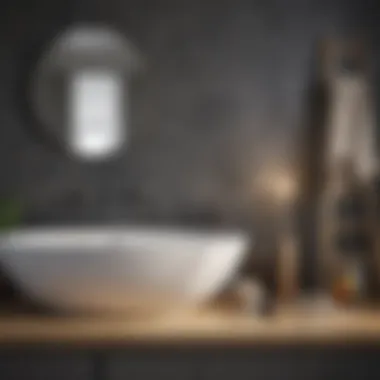Essential Labor Insights for Bathroom Renovation


Intro
Renovating a bathroom is a significant home improvement project that requires thoughtful consideration of various labor aspects. It is not merely about selecting tiles or fixtures; it also involves understanding labor options, costs, timelines, and the skills required. Recognizing these elements is essential for ensuring a successful renovation. This article aims to serve as a comprehensive guide, providing insights into the labor considerations inherent in bathroom renovations, tailored for housewives and homeowners.
Current Trends
In the realm of bathroom renovations, current trends reflect a blend of aesthetics and functionality. Homeowners increasingly seek spaces that not only perform well but also offer a sense of style and comfort.
Color Palettes
Recent trends show a preference for softer, neutral colors. Shades like soft whites, light greys, and muted pastels are favored as they create a calming atmosphere. Accents in darker hues, such as deep navy or forest green, are used strategically to add depth and drama.
Popular Styles
Modern minimalist design continues to dominate the bathroom space. This style emphasizes clean lines and uncluttered spaces. Additionally, vintage and rustic designs are making a comeback, showcasing reclaimed materials. These preferences influence the choice of labor, as skilled tradespeople may be needed to achieve these distinct styles effectively.
Labor Options for Bathroom Renovation
When it comes to labor, homeowners have several options. Choosing the right path can significantly impact the outcome of the renovation. Here are some common labor options:
- General Contractors: They oversee the entire project, coordinating between different professionals and managing timelines.
- Specialized Tradespeople: This includes plumbers, electricians, and tile installers. Hiring specialists ensures that significant details are handled correctly.
- DIY Efforts: Some homeowners opt to do it themselves for specific tasks. This can save costs, but it is crucial to assess one's skill level honestly.
Each option presents unique advantages and challenges. Using professionals may incur higher costs, but it often guarantees quality and adherence to building codes.
Cost Considerations
Budgeting for labor in a bathroom renovation involves understanding the costs associated with various labor options. Costs can vary widely based on location, project scope, and the professionals hired.
- General Contractor Fees: Often calculated as a percentage of the total project cost.
- Hourly Rates for Tradespeople: Rates can depend on the tradesman’s experience and area of expertise.
- DIY Expenses: If taking the DIY route, material costs need to be understood. However, hidden costs often arise when mistakes are made.
These factors contribute to the overall renovation budget, so careful planning is essential.
Timelines
Another critical consideration is the timeline for the project. Homeowners should expect variations based on the complexity of the renovation and the availability of labor.
- Simple Renovations: May take a few days to a week, focusing on cosmetic changes.
- Complete Overhauls: Could span several weeks, especially when multiple tradesmen are involved.
Setting realistic timelines helps in planning daily life around the ongoing work, minimizing disruptions.
Hiring Qualified Professionals vs. DIY
Weighing the decision to hire professionals versus taking a DIY approach requires careful thought. Hiring qualified professionals ensures that work is done according to local codes and standards. However, DIY projects can be fulfilling and cost-effective if approached with caution and proper research.
"Consider your skills honestly—some tasks demand expertise beyond basic knowledge."
Best Practices for Efficiency and Quality
To ensure both efficiency and quality throughout the renovation, following best practices can make a difference. Homeowners might consider:
- Detailed Planning: Create a clear, well-thought-out plan that includes all steps of the renovation.
- Clear Communication: Whether working with contractors or doing it yourself, maintaining open lines of communication helps in addressing issues quickly.
- Regular Inspections: Frequent checks during the renovation can catch potential problems before they escalate.
Understanding Bathroom Renovation
Bathroom renovation is a significant endeavor that can enhance both the functionality and aesthetic appeal of a home. Understanding the underlying elements of this process is crucial for homeowners and housewives aiming to achieve their renovation goals effectively. This section will elucidate the definition and scope of bathroom renovations as well as the common objectives that guide these projects.
Definition and Scope
Bathroom renovation refers to the process of updating or remodeling the existing bathroom space to improve its functionality and style. This can involve various tasks such as replacing fixtures, altering layouts, upgrading materials, and enhancing overall ambiance. The scope of a bathroom renovation can vastly differ depending on the project's goals. Some homeowners may aim for a complete overhaul, while others might focus on minor updates. It is essential to define the specific areas of focus early in the planning phase to ensure a smooth renovation process.
Common Objectives


When embarking on a bathroom renovation, homeowners typically have several objectives in mind. Common motivations include:
- Improving Functionality: Many homeowners wish to enhance the usability of their bathrooms, which may involve increasing storage options or reconfiguring the layout for better flow.
- Increasing Property Value: A well-executed bathroom renovation can significantly elevate the market value of a property, making it appealing to potential buyers.
- Updating Aesthetics: This often includes refreshing an outdated design, such as choosing modern fixtures or updated color schemes.
- Enhancing Comfort: Comfort features such as heated floors or better lighting can transform the bathroom into a more enjoyable space.
Renovations done with a clear understanding of the desired outcomes can lead to fewer mistakes, reducing time and cost in the long run.
Assessing Renovation Needs
Assessing renovation needs is an essential starting point for any bathroom renovation project. It establishes a framework guiding each decision, significantly influencing the project's direction and outcomes. Thorough assessment helps prioritize what must be accomplished while understanding the nuances of existing conditions. This phase ensures that the renovation addresses specific issues rather than focusing solely on aesthetics.
Identifying Priorities
Identifying priorities in a bathroom renovation involves understanding the most critical elements of the project. Homeowners should consider their lifestyle, functional needs, and design preferences. To begin, it may be valuable to ask:
- What do I dislike about my current bathroom?
- What are my must-have features?
- How often do I use the bathroom compared to other family members?
Creating a comprehensive list can help in narrowing down priorities. For example, a family with young children may prioritize safety features and durable materials, while a couple may focus on creating a spa-like atmosphere. Aligning the renovation with personal priorities not only enhances usability but also ensures satisfaction with the final result.
Evaluating Current Conditions
Evaluating current conditions is another vital aspect of assessing renovation needs. This step involves inspecting the existing bathroom layout, plumbing, and electrical systems. A thorough evaluation helps homeowners determine whether these elements can accommodate the planned changes without significant modifications.
Some factors to inspect include:
- Water and Drainage Systems: Are the plumbing and drainage systems functioning properly? Are there any leaks or damages that require immediate attention?
- Electrical Wiring: Does the electrical system meet current safety codes? Are there enough outlets to support new appliances or fixtures?
- Structural Integrity: Are there any signs of mold or water damage in walls or floors?
Correctly evaluating these aspects will help avoid costly surprises later in the renovation process. Additionally, it allows homeowners to set realistic expectations for timeframes and labor needs. Ultimately, understanding both the priorities and current conditions creates a solid foundation for effective planning, enabling a smoother renovation process.
"A well-thought-out assessment phase can save both time and money, ensuring that all aspects of the bathroom renovation align with the homeowner's vision and practical needs."
Labor Options for Bathroom Renovation
The selection of labor options for bathroom renovation is a fundamental aspect that can significantly influence both the quality and outcome of the project. Understanding the choices available helps homeowners make decisions aligned with their budget, project complexity, and desired aesthetics. This section explores professional contractors, DIY endeavors, and a combination of both approaches, each with its own merits and challenges.
Professional Contractors
Benefits of Hiring Professionals
One of the major benefits of hiring professionals is their expertise. Skilled contractors possess extensive knowledge about materials, building codes, and design trends. This expertise allows them to navigate potential pitfalls that homeowners might overlook. In addition, professionals bring efficiency. They have the tools, skills, and experience to complete tasks faster and more accurately compared to most amateur efforts.
Another characteristic is reliability. A reputable contractor is more likely to stick to timelines and deliver on quality. This can reduce stress for homeowners who might feel overwhelmed by managing the renovation themselves. However, hiring professionals usually comes at a higher cost, which is an important factor for many homeowners. The trade-off between cost and quality needs careful consideration.
Hiring professionals ensures a level of quality that enhances the overall renovation experience.
Choosing the Right Contractor
Choosing the right contractor is crucial for the success of the renovation. This process involves researching potential candidates and evaluating their past work and references. Ideally, a contractor should have a solid reputation supported by customer testimonials. It is also beneficial if they specialize in bathroom renovations.
Additionally, a key aspect to consider is communication. A contractor who listens to your needs and offers clear solutions will likely contribute positively. A poor fit in this area can lead to delays and dissatisfaction. However, the unique challenge of this choice is the potential for hidden costs that may arise if a contractor does not provide an accurate estimate or scope of work. This reinforces the need for thorough vetting.
DIY Labor
Advantages of DIY
Engaging in DIY renovations presents certain advantages. One significant benefit is the potential cost savings. By eliminating labor costs, homeowners can allocate their budgets elsewhere on materials or enhancements. Moreover, DIY projects tend to offer a personalized touch. Homeowners can directly influence the design and functionality based on their preferences.
However, it's important to acknowledge the time commitment required for DIY projects. Beginners may find themselves spending more time learning tasks rather than completing them efficiently. The unique aspect of DIY is the satisfaction derived from completing the project independently, yet this can lead to mistakes if skill levels do not match the task at hand.
Typical DIY Tasks
Typical DIY tasks in bathroom renovations vary widely, yet there are several common projects homeowners can undertake. Painting walls, installing tiles, and replacing fixtures are often manageable for those with basic skills. Removing old cabinets or vanities also falls within the DIY scope, provided the proper tools and safety precautions are in place.


The key advantage of these tasks is skills development. Homeowners can gain a sense of accomplishment as they acquire new abilities. Nevertheless, the risks of embarking on complex projects without adequate experience may result in costly mistakes and frustrating delays. The potential to misjudge personal capabilities must be considered seriously.
Combination Approach
Adopting a combination approach might provide the best of both worlds. Homeowners can choose to handle simple tasks themselves while leaving the more complicated aspects to professionals. This strategy maximizes budget efficiency while still allowing for personal input. However, homeowners need to communicate clearly with contractors about their plans to ensure seamless coordination. Misunderstandings may lead to conflicting work schedules or overlapping tasks that can complicate the renovation process.
Cost Considerations
Understanding the cost considerations in a bathroom renovation is crucial. This entails evaluating all aspects related to labor expenses, which can significantly impact the overall budget. The choice between professional contractors and DIY efforts plays a vital role in determining the final financial commitment needed. Moreover, comprehending labor rates, effectively budgeting, and being aware of hidden costs can enable homeowners to manage their renovation projects more efficiently. It is not just about the initial outlay, but also about planning for potential expenses to avoid unpleasant surprises.
Labor Rates Overview
Labor rates for bathroom renovation can vary widely based on several factors. Factors such as location, contractor expertise, and the complexity of the work all contribute to these variations. For example, in metropolitan areas, labor costs tend to be higher due to increased demand and a higher cost of living. On average, professional contractors may charge between $50 to $120 per hour. This rate may include costs related to their experience, tools, and overhead costs associated with running a business.
It's essential for homeowners to gather multiple quotes. Comparing different labor rates can help in making informed choices. Be sure to scrutinize what these rates include. For example, does the quote cover material costs, or is it purely for labor?
Budgeting for Labor Costs
Budgeting is a critical step in any renovation project. Start by estimating labor costs based on the quotes received and the expected time to complete the project. Adding a buffer of around 10-20% of the anticipated costs is wise to account for unforeseen expenses.
In addition to direct labor costs, other factors must be considered:
- Permit and Inspection Fees: Depending on the scope of work and local regulations, permits might be required. Always account for these in your budget.
- Materials and Supplies: If a contractor is handling procurement, ensure that these costs are included in the total labor estimate.
- Contingencies: Problems can arise during renovations, from plumbing issues to electrical concerns, which could substantially affect your budget.
Hidden Costs of Renovation Labor
Hidden costs are a common pitfall for homeowners. While planning the renovation, keep in mind that there can be expenses that are not immediately apparent. These can include:
- Finishing Touches: Finalizing installations, trim work, or repainting often requires additional labor that is not included in initial estimates.
- Post-Completion Repairs: Sometimes renovations unveil underlying issues that require immediate professional attention, such as mold or structural concerns.
- Increased Utility Bills: After a renovation, some homeowners notice an increase in their utility bills, especially if energy-efficient systems or fixtures were not included in the renovation plan.
Understanding labor costs in detail allows homeowners to align their budget of the project with realistic expectations. It encourages smarter planning and reduces the likelihood of budget overruns.
"Investing time in understanding labor costs can lead to substantial savings and smoother renovation experiences."
Remember, thorough planning and diligent execution are key to managing the financial aspects of your bathroom renovation.
Timelines and Scheduling
Timelines and scheduling are fundamental aspects of bathroom renovation. They dictate the overall flow of the project and have implications for budgeting, labor availability, and stress levels. Understanding the timeline needed for various tasks ensures that the renovation process proceeds smoothly. Poor scheduling can lead to delays, which may escalate costs and extend the duration of inconvenience for homeowners. Thus, careful planning around time can improve the efficiency of the entire renovation.
Estimated Timeframes for Different Labor Types
When planning a bathroom renovation, it is useful to know the expected timeframes for different types of labor. The nature of the work greatly influences how long the project will take. For example, professional contractors typically provide more rapid results because they have experience and the necessary workforce. Common labor types and their rough time estimates include:
- Demolition: This usually takes a few hours to a couple of days, depending on the project's size.
- Plumbing work: Generally lasts from one to three days, depending on the complexity of the plumbing installation.
- Electrical work: This can take anywhere from one to two days, contingent on the number of fixtures and updates needed.
- Tile installation: Expect anywhere from two days to a week based on the bathroom size and design complexity.
- Finishing touches: Tasks such as painting and installing fixtures often require a day or two.
Homeowners may wish to create a more detailed timeline with specific job durations to coordinate between different labor types efficiently.
Scheduling Considerations for Renovation Projects
Scheduling is another crucial element in the renovation process. Proper scheduling helps mitigate delays and ensures all tasks flow logically. Here are essential considerations to keep in mind:
- Project Sequence: Make sure that work is scheduled so that each task does not interfere with another. For example, tiling must occur before the installation of fixtures.
- Availability of Labor: Check and confirm the availability of hired professionals or tradespeople well in advance. This avoids last-minute surprises.
- Material Lead Times: Some materials may require longer lead times to procure. It is wise to order these first.
- Contingency Time: Always add extra days as buffer time in the schedule. Unexpected delays can arise due to unforeseen issues, such as structural repairs.
- Flexibility: Life can be unpredictable. Be prepared to adjust schedules as needed to accommodate any arising challenges.
Effective time and scheduling strategies can lessen stress and ensure a more efficient renovation process.
Quality Control in Labor Management
Quality control in labor management is a vital aspect of any bathroom renovation project. Ensuring that work meets not only aesthetic standards but also conforms to safety and regulatory guidelines is essential. Poor quality control can result in costly fixes, project delays, and can detract from the overall value of the renovation.
One of the primary benefits of implementing effective quality control measures is the assurance that the work is done right the first time. This includes routine checks throughout the various stages of the project. By maintaining a high standard from the outset, homeowners can avoid many common pitfalls that lead to complications later. In addition, this systematic approach helps contractors stay accountable and fosters a culture of diligence and care among laborers.


Having a plan for quality control also streamlines communication between all parties involved. Clear expectations can significantly reduce misunderstandings. Everyone, from the contractors to the homeowners, has a shared understanding of what constitutes acceptable work quality.
The Importance of Supervision
Supervision plays a critical role in quality control. A well-supervised workforce is more likely to adhere to established standards and guidelines. This oversight often involves regular site visits and check-ins at key milestones of the renovation process.
When supervision is lacking, the risk of subpar work increases. Workers may cut corners or misinterpret project specifications. By ensuring effective supervision, homeowners can reduce the likelihood of errors and ensure that tasks are being performed correctly. Engaging a project manager or a lead contractor who oversees all the activities can help mitigate these risks.
Ensuring Compliance with Building Codes
Compliance with building codes is non-negotiable in bathroom renovations. These codes are established to ensure the safety and functionality of structures. Each locality may have different requirements, and it is essential to understand them. This is where quality control intersects with regulatory compliance.
Make sure that all labor involved is fully aware of and adheres to these codes. Regular inspections should be conducted to confirm that any installation meets building code requirements. This vigilance not only shields homeowners from future legal consequences but also enhances the longevity and safety of the renovations.
"Quality means doing it right when no one is looking." - Henry Ford
Implementing these practices will pay dividends in safety, satisfaction, and ease of mind for house owners.
Post-Renovation Considerations
Understanding the implications of post-renovation is vital for homeowners. After the completion of a bathroom renovation, the focus shifts from construction to maintaining new improvements. Such considerations impact both the aesthetic value and functional longevity of the renovated space. It is essential to address various aspect that can influence your satisfaction with the completed project.
Evaluating Renovation Outcomes
Once the renovation project wraps up, the first step is to evaluate the outcomes. This involves a thorough inspection of all the new installations. Homeowners should check the plumbing, electrical components, tiles, and fixtures to ensure they all function correctly. Here are a few key points to observe:
- Functional Assessment: Ensure that everything operates as intended. Turn on faucets, test the toilet, and check lighting.
- Aesthetic Review: Look for any mismatches in design elements, such as colors or finishes that do not align with your vision.
- Quality Checks: Inspect for gaps, cracks, or any visual defects that may be present, indicating a need for repair or adjustment.
The evaluation process helps in identifying any deficiencies early, preventing them from becoming more significant issues in the future.
Maintenance Plans for Longevity
Creating a maintenance plan after your renovation is critical for extending the life of your newly installed features. An effective plan can lessen the likelihood of unexpected repairs that often arise from neglect. Here are several components to include in your maintenance strategy:
- Routine Inspections: Regularly check all areas, focusing on plumbing connections and fittings for leaks.
- Cleaning Schedule: Establish a cleaning schedule to maintain surfaces. This avoids buildup that could damage finishes over time.
- Seasonal Adjustments: Adjust plans based on seasonal changes, like protecting plumbing during winter months to prevent freezing.
A well-structured maintenance plan enhances the durability of your bathroom renovation, ensuring it remains a beautiful and functional space for years to come.
Taking time to evaluate outcomes and implement a maintenance plan greatly contributes to the value and longevity of your renovation.
By focusing on these post-renovation considerations, you can maximize the return on your investments and enjoy the results of your hard work.
Finale and Future Insights
In considering bathroom renovation, it is crucial to understand the labor implications. This section serves as a guide to consolidate the vital information discussed throughout the article. A well-executed renovation relies not only on your vision but also on efficiently managing labor resources. The insights presented here underscore the importance of planning, choosing the right labor option, and being aware of evolving trends in the industry.
The key benefits of acknowledging the labor aspects are multi-fold. First, it ensures that you stay within budget while receiving quality work. Effective management of labor can lead to increased efficiency, minimizing downtime during renovations. Additionally, recognizing the trends in bathroom renovation labor can give homeowners a competitive edge when planning their projects.
There are also significant considerations to keep in mind. These include the legal requirements associated with hiring professionals, the potential complications of DIY projects, and how to deal with unforeseen challenges during the renovation process. The future of bathroom renovation labor will likely involve a greater emphasis on skilled labor and sustainability. Homeowners must stay informed about these shifts to make decisions that align with their long-term goals.
"Understanding labor considerations is essential for a successful bathroom renovation. Knowledge is the key to making informed choices."
Ultimately, integrating these elements into your renovation plan will enhance the overall success of the project. By being thorough in addressing labor inputs, you can transform your bathroom while ensuring quality workmanship and a timely completion.
Summary of Key Points
In this article, we have explored several critical aspects regarding labor considerations in bathroom renovations:
- The choice between hiring professionals and DIY labor can significantly affect project outcome.
- Understanding labor costs is essential for budgeting and financial planning.
- Quality control requires supervision and compliance with building codes.
- Assessing renovation needs and evaluating current conditions helps in setting priorities.
- A combination of different labor types can optimize the effectiveness of your renovation strategies.
These points provide essential context for homeowners aiming to manage their renovation projects effectively.
Trends in Bathroom Renovation Labor
The bathroom renovation landscape is evolving rapidly. Several trends are reshaping how labor is approached in this sector:
- Skilled Labor Shortage: Many regions face a shortage of skilled labor, making it essential for homeowners to secure reliable contractors early in the planning phase.
- Green Building Practices: There is a growing trend toward sustainable renovation practices. Homeowners increasingly prefer contractors who specialize in eco-friendly installations and materials.
- Smart Home Integration: As technology becomes more prevalent, there's a demand for labor skilled in integrating smart home features into renovations.
These trends indicate that successful renovation projects will increasingly rely on both innovative practices and skilled professional labor. Homeowners who stay attuned to these changes will be better equipped to make informed decisions and achieve their desired results.



